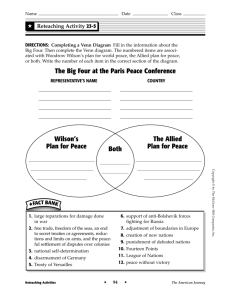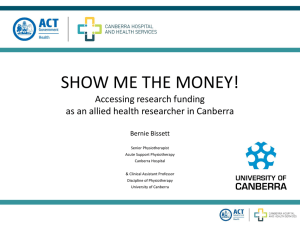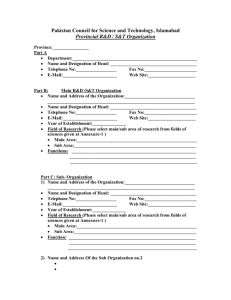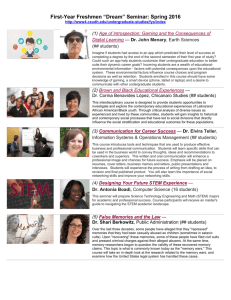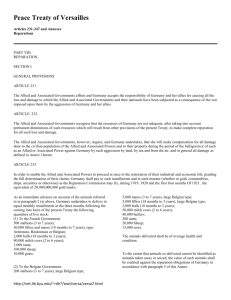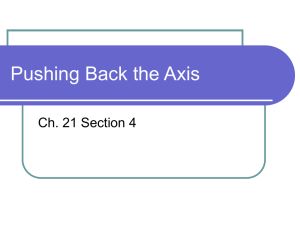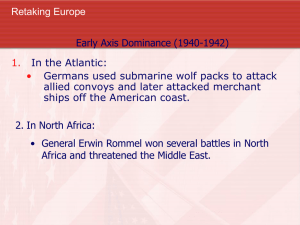Curriculum resources for cultural diversity education Bamberg
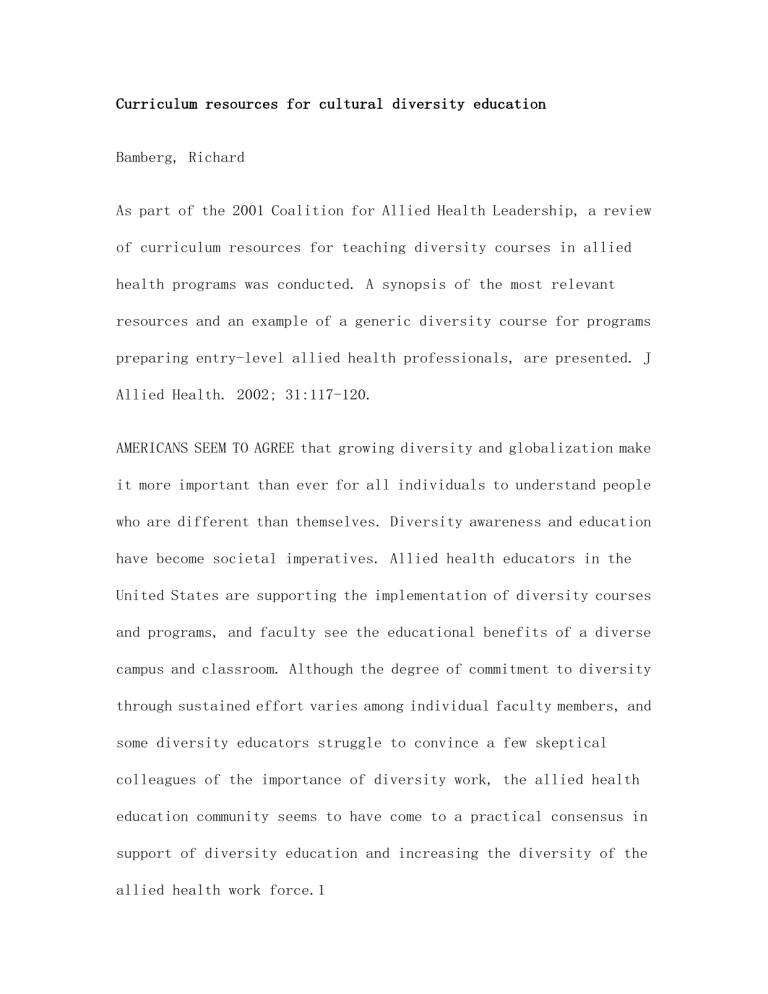
Curriculum resources for cultural diversity education
Bamberg, Richard
As part of the 2001 Coalition for Allied Health Leadership, a review of curriculum resources for teaching diversity courses in allied health programs was conducted. A synopsis of the most relevant resources and an example of a generic diversity course for programs preparing entry-level allied health professionals, are presented. J
Allied Health. 2002; 31:117-120.
AMERICANS SEEM TO AGREE that growing diversity and globalization make it more important than ever for all individuals to understand people who are different than themselves. Diversity awareness and education have become societal imperatives. Allied health educators in the
United States are supporting the implementation of diversity courses and programs, and faculty see the educational benefits of a diverse campus and classroom. Although the degree of commitment to diversity through sustained effort varies among individual faculty members, and some diversity educators struggle to convince a few skeptical colleagues of the importance of diversity work, the allied health education community seems to have come to a practical consensus in support of diversity education and increasing the diversity of the allied health work force.1
The consensus for diversity education seems to be supported by the employers of allied health professionals. Diversity education enables faculty and students to learn crucial skills, including communicating with individuals of differing backgrounds, teamwork, and problem solving, all of which are essential to success in an increasingly multicultural patient population and work force. In a multiethnic society, it is important for health care providers to understand the range of cultural behaviors and the health behaviors and lifestyles of people in the context of the patient's cultural perspective.
Purpose of Project
We undertook a diversity project as a requirement of the 2001 Coalition for Allied Health Leadership program. The diversity project encompassed two facets as follows: 1) identifying relevant literature and audiovisual resources that could be used as background readings and viewings or in other ways as part of diversity courses in allied health curricula and 2) formulating an example syllabus for a course that can be used in curricula preparing entry-level allied health professionals.
Resources for Teaching Cultural Diversity
Following is an alphabetical list of print and audiovisual resources that can be used as components of diversity courses. Each resource has a brief synopsis of the resource content.
1. Batts V Modern Racism: New Melody for the Same Old Tunes. EDS
Occasional Papers, No. 2. Cambridge, MA: Episcopal Divinity School,
1998.
Detailed and thorough examples of the numerous ways in which modern racism has become more covert and hidden but still is present in our professional and personal lives, including interpersonal and institutional racism, are described in this publication. The impact of covert racism of whites toward minority groups is discussed, including internalized oppression.
2. Batts V, Brown JL. Multicultural Process of Change: Assumptions and
Definitions. Cambridge, MA: Visions, Inc, 1991.
This publication includes a comprehensive vocabulary of diversity terms and ground rules that can be used in diversity discussions and dialogues. Group exercises to enable participants to develop a working knowledge of the common vocabulary, grasp the concept of target and nontarget groups, and understand the many forms of overt and covert
oppression as well as the levels and types of oppression inflicted on target groups, are also presented.
3. The Essential Blue Eyed: Trainer's Edition. San Francisco, CA:
California Newsreel, 1999.
This videotape documents an experiment done by Jane Elliot, an elementary teacher in a small town in Iowa in the 1960s. The experiment was done after the assassination of Martin Luther King, Jr. Students were classified as either inferior or superior based on eye color and treated each other accordingly. The inferior and superior students switched on day 2 so that all students experienced being treated as inferior and as superior. The documentary is a powerful statement of the impact of prejudice on feelings and performance for target and nontarget groups.
4. Brisbane FL, Epstein LG, Pacheco G, Quinlan JW Cultural Competence for Health Care Professionals Working with African-American
Communities-- Theory and Practice. Washington, D.C.: U.S. Department of Health and Human Service, 1998,
The fact that most health care services are anchored in elements of the mainstream (i.e., white) culture, which may or may not be related to the culture of African-Americans, and are sometimes corrosive to
the health of minority groups is described in this book. Suggestions for ways to develop medical, mental health, and health promotion services that are anchored to the specific cultural/ethnic patient population to which the health services are directed are provided including redefining health from a community environment perspective, focusing on community vulnerability rather than solely on individual pathology, empowering clients rather than fixing them, building community strengths and role models, and identifying the most powerful points of intervention for the over-- all community as connected to its culture.
Griger J, Davidhinger R. Transcultural Nursing: Assessment and
Intervention. 3rd ed. Philadelphia: Mosby, 1999.
Although written for nursing practice, this resource provides a historical and biotechnical approach to transcultural care that is applicable to multiple health disciplines. This book describes the application of specific nursing assessment and intervention techniques across the 16 most common cultural and ethnic groups encountered in the U.S. health care environment.
6. Gropper RC. An Intercultural Sensitizer for the Health Professions:
Culture and the Clinical Encounter. Yarmouth, ME: Intercultural Press,
1996.
This book uses crucial incidents to educate health professionals about the importance of cultural differences in clinical encounters. Each incident presents a cross-cultural conflict or problem in a clinical context and an explanation of the cultural basis for the conflict, including misinterpretation of cues to act or clashes between hierarchies of values.
7. Hidalgo NM. Multicultural teacher introspection. In: Perry T,
Fraser J (eds). Freedom's Plow: Teaching in the Multicultural
Classroom. New York: Routledge, 1993, pp. 99-106.
Although oriented toward public school educators, this book offers numerous insights for establishing open dialogue and introspection exercises for teachers to reflect on their own cultural awareness and sensitivity and how it translates to their actions in the classroom.
The group exercises described provide participants insights regarding the stereotypes and false beliefs they may hold about other cultures and ethnicities and an understanding of the similarities inherent in diversity.
8. Jibaja ML, Sebastian R, Kingery P, Holcomb JD. The multicultural sensitivity of physician assistant students. J Allied Health. 2000;
29:79-85.
This journal article contains a 21-item scale that measures cultural sensitivity. The Multicultural Sensitivity Scale can be used to do preassessments and postassessments of participants' cultural sensitivity scores to evaluate the impact of a diversity course.
9. Luckmann J. Transcultural Communication in Health Care. Albany, NY.
Delmar, 2000.
This book enables health professionals to develop specific skills and techniques that can be used to provide culturally competent communication, including listening, observation, nonverbal communication, and verbal communication. Each chapter contains a self-- evaluation at the beginning of the chapter and an instrument that readers can use to evaluate their development of the specific skill or technique.
10. Lutzker M. Multiculturalism in the College Curriculum: A Handbook of Strategies and Resources for Faculty. Westport, CT Greenwood Press,
1995.
This book is written for instructors in any discipline who believe that incorporating diversity content in their courses is important.
Specific and practical sug. gestions for making small additions and
changes, but not large-scale restructuring, in individual course syllabi that could be used in allied health disciplines are described.
11. Meacham J. Curriculum Transformation: Assessing Diversity Courses.
College Park, MD: Diversity Web, Diversity Links, developed by
Association of American Colleges and Universities and the University of Maryland, September 1999. Available at: http://www.diversityweb.org/Leadersguide/CT/Principles_practices/A ssdivcour.html.
This internet resource describes considerations in evaluation of diversity courses and how it differs from the usual student evaluation of instruction used in most college courses. The importance of interim and end-of-course evaluation procedures in diversity courses is emphasized.
12. Morey Al, Kitano MK. Multicultural Course Transformation in Higher
Education: A Broader Truth. Needham Heights, MA: A Viacom Company,
1997.
The development of diversity courses is described from a holistic viewpoint in this resource. Considerations, strategies, and techniques for development of content, instructional approaches, and assessment procedures and classroom dynamics are presented.
13. Salett EP, Koslow DR. Race, Ethnicity and Self: Identity in
Multicultural Perspective. Washington, D.C.: National Multicultural
Institute, 1994.
Although specific applications to development of a diversity course are not presented in this book, this resource can be used as background reading in such a course. It provides insight as to the psychosocial development and integration into U.S. culture for African-- Americans,
Puerto Ricans, Asian Americans, and Native Americans, and for biracial persons.
14. Salimbene S. What Language Does Your Patient Hurt In? (A Practical
Guide to Culturally Competent Patient Care). Amherst, MA: Diversity
Resources, 2000.
This book is a practical guide designed to help health care professionals understand the needs, expectations, and behaviors of multicultural patient populations. It provides essential information for providing culturally sensitive health care to six different cultures (African-American, Native American, Asian, Hispanic, Islamic, and persons from the former Soviet block countries).
15. Spector RE. Cultural Diversity in Health and Illness. 3rd ed. East
Norwalk, CT: Appleton & Lange, 1992.
Although written for students in basic nursing education, this book is practical and applicable to multiple health disciplines. This resource contains three major sections: 1) provider self-awareness,
2) issues of delivery and acceptance of health care, and 3)traditional values of health and illness from the perspective of six different nonwhite cultural/ethnic groups.
16. Tutu and Franklin: A journey Towards Peace. Washington, D.C.:
Wisdom Works, 2000.
This 2-hour videotape documents the dialogues and interactions of
Nobel recipient Archbishop Desmond Tutu and U.S. historian John
Franklin Hope with a group of 21 international teenagers as they discuss a multitude of issues, including their nations' struggles for peace, personal identity, dating, affirmative action, intermarriage, and apologies for past injustices. This emotional journey toward racial reconciliation, which takes place on the original slave port of Gore Island off the coast of West Africa, can be used as a backdrop for dialogues and discussions in a diversity course.
Cultural Diversity Course
Following is the syllabus for a 16-contact hour cultural diversity course that could be used for students in an academic program preparing
entry-level allied health professionals. The syllabus also could be used as a continuing education workshop. The course emphasizes knowledge of and interaction with other cultures and ethnicities.
Course Title: Cultural Diversity for Health Care Delivery in the 21 st Century
Course Text: What Language Does Your Patient Hurt In? (A Practical
Guide to Culturally Competent Patient Care) by S. Salimbene.
Course Objective: To increase awareness of and sensitivity to cultural diversity issues and provide appropriate high-quality health care by understanding the needs, expectations, and behaviors of multicultural patient populations.
Course Requirements: Requirements for this course include four reaction papers, a term experience, a research paper, and an oral presentation. All written assignments must be typed and will be graded on quality of writing (grammar, spelling, formatting, and neatness) and content (what you say, organization, clarity). In-class assignments will require that students view videos and participate in the structured experiences and class discussions. Students must complete assignments before coming to class.
1. Each 1-page reaction paper should include an evaluation of the assigned video, structured experience, or class discussion topic.
Support your reactions and conclusions from your personal experiences with cultural diversity.
2. A term experience which will consist of at least six, 1-hour weekly discussions, observations, or other shared experiences with someone who is experiencing an illness or disease and who is different from you relative to culture, race/ethnicity, or age. If you choose age, the person must be over 55 years old. Other differences, such as transgender or sexual orientation, may be considered but must be preapproved by the instructor. The intent of the term experience is to meet and learn about someone new who is different from you and who could be your patient or client. Keep a weekly journal describing your meetings. The journal will be discussed in more detail by the instructor.
3. The term experience will form the basis for a written research paper.
In your paper explain what you already knew about the difference.
Second, share what new information or insights you have gained about the difference from your term experience. Share your thoughts, feelings, and approaches you would use in caring for this person if he or she were your patient or client. You are sharing your approach
to dealing with the type of care or services you would provide the patient or client based on cultural perspectives. Research the difference and present what you find. Your written research paper must be at least eight pages in length and have a minimum of four references, only one of which may be from the Internet. The paper will be evaluated on the quality of writing and content.
4. You also will present what you learned from your term experience to the class as an oral presentation. You will answer any questions from the instructor or your fellow students and lead any discussion that ensues about the difference you experienced. Your presentation will be evaluated on organization, clarity, presentation style, and content.
GROUND RULES FOR OUR CLASS DiSCUSSIONS
1. Share the Air Time! Everyone's participation is encouraged. Please monitor your own participation level. If you are someone who often speaks up, be sure you also are allowing opportunities for others to participate. If you are someone who is hesitant to speak in groups, use this opportunity to stretch yourself.
2. Confidentiality Is Important! Share the ideas from the course with your friends and acquaintances, but personal statements and experiences should be kept in the classroom and remain confidential.
3. Mutual Respect Is Important! Diverse perspectives are to be expected.
When necessary, we can agree to disagree and do so in a mutually respectful way. We all are "works in progress." We need to listen carefully to each other and recognize that all of us are here to learn.
4. Speak From Your Own Experience! When talking about difficult topics, it is easy to slip into a pattern of talking about what "others" or
"they" think. Try to avoid doing this. Use "I" statements, not "We" or "They" statements.
5. Risk Taking Is Encouraged! If you have a question, ask it! No one is here to judge or criticize you.
TOPICAL OUTLINE FOR CLASS (2-HOUR CLASS SESSIONS)
Classes 1 and 2: Lecture on practical guidelines to culturally competent patient care based on content of textbook.
Class 3: View "The Essential Blue Eyed" videotape, followed by class discussion. Describe term experience, weekly journal, and research paper.
Assignment: Write reaction paper 1 on the videotape and turn-in at class 4.
Class 4: Lecture on improving the cross-cultural caregiver and the patient relationship based on content of textbook.
Class 5: Brief lecture on racial stereotypes based on content of textbook, followed by class discussion.
Assignment: Write reaction paper 2 on race and turn in at class 6.
Class 6: Brief lecture on language and communication style in culturally competent patient care based on content of textbook, followed by class discussion.
Assignment: Write reaction paper 3 on language and communication style and turn in at class 7.
Class 7: Brief lecture on cultural behavior and cultural conflict in patient care based on content of textbook, followed by class discussion.
Assignment: Write reaction paper 4 on cultural sensitivity and turn in at class 8.
Class 8: Term experience oral presentations; turn in research papers.
The course template for "Cultural Diversity for Health Care Delivery in the 21st Century" provides a format that can be modified or expanded based on an individual institution's allied health student needs.
Numerous other resources described earlier in this article could be included in such a diversity course for allied health professions students. The resources provide a wealth of other content, skills, techniques, and class exercises that could be incorporated into a diversity course depending on the contact hour allocation of the course.
REFERENCE
1. Implementation Task Force of the Commision on Allied Health.
Building the Future of Allied Health. Washington, D.C.: Health
Resources and Services Administration, 1999.
Richard Bamberg, PhD, MT(ASCP)SH, CLD(NCA), CHES Bessie B. Pitts, MS,
LPC, LSW Eileen M. Maloney, MEd, RT(R)(M), FASRT
Dr. Bamberg is professor and chair, Department of Clinical Laboratory
Science, School of Allied Health Sciences, East Carolina University,
Greenville, North Carolina; Ms. Pitts is assistant dean, Health
Technologies Division, Cincinnati State Technical and Community
College, Cincinnati, Ohio; and Ms. Maloney is vice president, American
Society of Radiologic Technologists, Passaic County Community College,
Paterson, New Jersey.
Address correspondence and reprint requests to: Richard Bamberg, PhD,
Department of Clinical Laboratory Science, School of Allied Health
Sciences, East Carolina University, Greenville, NC 27858-4353; telephone: (252) 328-4417; fax: (252) 328-4470; e-mail: .
Copyright Association of Schools of Allied Health Professions Summer
2002
Provided by ProQuest Information and Learning Company. All rights
Reserved
